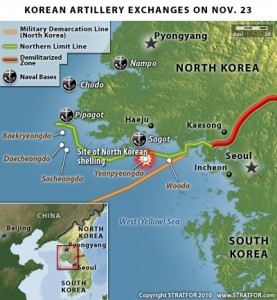 http://www.smh.com.au/world/north-korean-dictatorinwaiting-linked-to-deadly-artillery-attack-20101123-185p1.html
http://www.smh.com.au/world/north-korean-dictatorinwaiting-linked-to-deadly-artillery-attack-20101123-185p1.html
NORTH KOREA has burnished the leadership credentials of its 26-year-old dictator-in-waiting with a deadly artillery attack on South Korean territory, causing its neighbour to return fire and scramble F-16 fighters.
Two South Korean marines died, and at least 12 were wounded. There were reports of civilian injuries and houses were set ablaze as scores of shells fell on Yeonpyeong island.
A North Korea expert at Beijing’s Central Party School, Zhang Liangui, told the Herald that Kim Jong-un was deliberately destabilising the environment in order to mobilise the military and consolidate his power.
Advertisement: Story continues below
Flashpoint . . . smoke billows from houses on Yeonpyeong island after the North Korean artillery barrage. Photo: AFP
The South Korean President, Lee Myung-bak, held an emergency meeting and told officials to ”respond sternly” but to avoid aggravating the situation. The military were placed on high alert.
North Korea accused South Korea of firing first. ”The South Korean enemy, despite our repeated warnings, committed reckless military provocations of firing artillery shells into our maritime territory near Yeonpyeong island,” the military supreme command said.
The north’s military ”will continue to make merciless military attacks with no hesitation if the South Korean enemy dares to invade our sea territory by 0.001 mm”, it said in the statement carried by the official news agency. ”It is our military’s traditional response to quell provocative actions with a merciless thunderbolt.”
There have been previous skirmishes along the border – including the deaths of 46 South Korean sailors when the corvette Cheonan was torpedoed on March 26 – but the stakes are getting higher.
The exchange follows the revelation last week of a hitherto unknown North Korean uranium enrichment plant to a visiting US scientist. Siegfried Hecker, who previously directed the Los Alamos National Laboratory, told The New York Times he had been ”stunned” by the plant’s sophistication. North Korea said it was operating 2000 centrifuges.
If verified, this would take Pyongyang towards creating a far more powerful arsenal than the estimated eight to 12 plutonium-based warheads that have been built over the past five years.
The US special representative for North Korea, Stephen Bosworth, arrived in Beijing last night to brief officials on North Korea’s new enrichment facilities.
Chinese North Korea specialists believe the brinkmanship is designed to mobilise the country around the anointed successor of Kim Jong-il, his son Kim Jong-un.
A Chinese Foreign Ministry spokesman expressed ”concern” at yesterday’s attack and warned against further escalation. He said it was ”imperative” that six-nation talks aimed at ending North Korea’s nuclear ambitions be resumed.
A French diplomatic source said the United Nations Security Council would hold an emergency session.
The White House said it was ”firmly committed to the defence” of its ally, Seoul.
The Prime Minister, Julia Gillard, was briefed on the situation last night. She condemned the attack and said Australia was consulting closely with South Korea, Japan and the US.
Professor Zhang said the latest incident was unlikely to escalate because the North was mainly ”venting anger”.
Beyond the succession, he said the North wanted concessions from the South and to be acknowledged internationally as a nuclear state.
